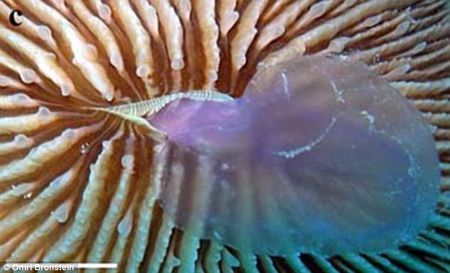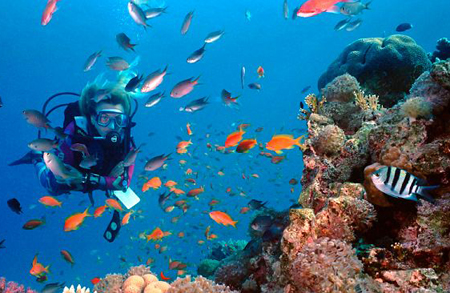Coral reefs re-eat jellyfish
The jellyfish is quite large and fast moving, but they are swallowed up by an almost immobile marine creature, the mushroom coral.

Jellyfish are sucked into the mushroom coral mouth in the Red Sea.Photo: Omri Bronstein.
Some Bar-Ilan University scientists and Tel Aviv University (Israel) captured the sight of moonfishes (Aurelia aurita) being sucked into the mushroom coral (Fungia scruposa) when they surveyed the reefs at Red sea earlier this year.
"During the survey we saw some mushroom corals actively swallowing the moonfish. We were shocked by the sight," Ada Alamaru, a member of the group, told Daily Mail.
According to Alamaru, jellyfish swim down to avoid seabirds and sea turtles, but are swallowed by coral mushrooms. Similar scenes are common in the seabed, but we rarely see with the naked eye. What scientists care about is how do corals catch jellyfish?
Mushroom corals - about 25 cm in diameter - hardly move even though they are not tied to the seabed.
"This is the first time the sight of corals eating recorded similar sized jellyfish. In fact we see that behavior in many corals, not one," Alamaru said.

Scientists discovered the sight of coral mushrooms eating moonfish when surveying coral reefs in the Red Sea.Photo: Daily Mail.
Daily Mail said, mushroom corals have wide mouths, live fixedly and do not combine together to form coral reefs. These are the opposite points to the rest of the coral world. Their main food is plankton (maximum size about 25 mm). Meanwhile the moon jellyfish has a diameter of 130 mm - half the size of mushroom corals.
Alamaru argues that eating jellyfish can help coral mushrooms supplement many valuable proteins. She said the number of jellyfish in the oceans has skyrocketed in recent years due to global warming.
"The ability to diversify food sources and utilize the boom of jellyfish helps mushroom corals have a big advantage in the fierce competition with other corals," Alamaru commented.
Alamaru's findings and colleagues are published in Coral Reefs, a publication of the International Coral Research Association.
- Nearly one third of Indonesia's coral reef area has been destroyed
- Explore the coral
- Rescue coral reefs worldwide
- The area of global coral is shrinking too fast
- Nearly 1 billion VND regenerates Khanh Hoa's coral reef
- Philippine paradise reef remains intact even though the world is in danger
- High water temperatures are one of the factors that damage coral reefs
- Indonesia restores 50% of the destroyed coral area
- Why are coral reefs in the world disappearing?
- Vietnamese marine corals are severely destroyed
- Vietnam faces unprecedented storms and floods if the coral reef is lost
- Coral Barrier - Coral Barrier
 Surprised: Fish that live in the dark ocean still see colors
Surprised: Fish that live in the dark ocean still see colors Japan suddenly caught the creature that caused the earthquake in the legend
Japan suddenly caught the creature that caused the earthquake in the legend A series of gray whale carcasses washed ashore on California's coast
A series of gray whale carcasses washed ashore on California's coast Compare the size of shark species in the world
Compare the size of shark species in the world